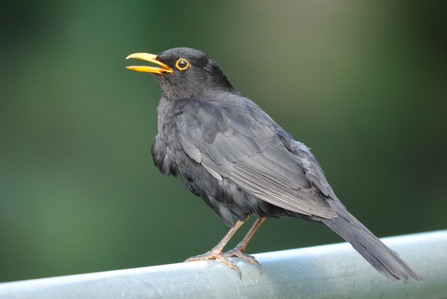
Singing blackbird ©Amy Lewis
There’s no growth on a dead planet. Why Part 3 of the Planning and Infrastructure Bill is a big problem for wildlife.
The Planning and Infrastructure Bill currently passing through Parliament is being framed by Government as the long-awaited remedy for stunted growth AND nature’s decline.
But, in reality – whilst the proposed treatment might offer the economy a brief revival – it threatens to thwart long-term health and prosperity by undermining, not strengthening, our natural infrastructure and life-support systems.
During the second reading of the Bill, the Government went out of its way to stress the potential “win-wins” for nature and economy. Part 3 of the Bill sets out its proposed radical new approach to dealing with environmental impacts of development.
The plan is to fast-track and streamline current environmental rules by creating a simple ‘nature restoration fund’ that developers can pay into, via a one-off ‘levy’, to account for the damage they may inflict on wildlife and nature. This would then enable Natural England and partners to deliver nature restoration at speed and scale.
Don’t get us wrong – nature restoration at speed and scale is exactly what we need and have needed for decades. By any measure, nature in the UK is still in freefall and we have 5 years to meet the Government’s own commitments to halt this decline and secure 30% of land and sea for nature’s recovery. We know that is going to take a herculean effort.
So why are we, and many in the environmental, planning, development and construction sectors now complaining when the Government has come forward with a possible solution?
Fundamental principles at risk
Because, appealing as it sounds, it comes with huge risks of breaking fundamental principles that protect the natural environment, while also adding cost and bureaucracy to the planning process.
Indeed, it’s the biggest change to environmental laws for a generation and comes off the back of recent Government rhetoric that falsely framed wildlife protection as a ‘blocker’ to development.
As it stands, this Bill raises a lot of questions and it would see the status of nature in law diminish, with potentially devastating consequences for the prospects of all.
The introduction of a ‘nature restoration levy’ removes three critical pillars of effective environmental governance: the 'precautionary principle', which prevents destruction before we fully understand what’s at stake; the 'mitigation hierarchy', which encourages developers to avoid harm in the first place rather than simply pay to trash; and, 'the polluter pays principle', replaced by a simple levy on all developments.
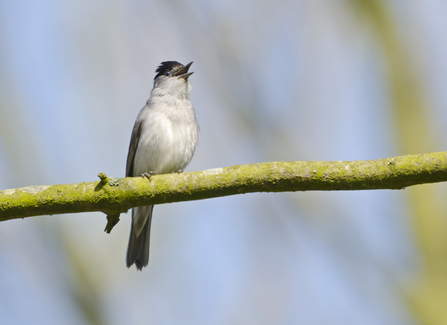
Singing blackcap ©David Tipling/2020VISION
The Bill, as currently drafted, would allow for an informal estimation of overall harm and assessment of the appropriate tariff to be paid by developers to ‘make good’, in line with ‘Environmental Delivery Plans’ (EDPs) to be crafted and delivered by Natural England.
The Bill introduces a new concept, the so-called “overall improvement test”, but this is vague, legally flimsy and open to manipulation. The Secretary of State for Housing would also have the discretion to determine whether this test has been met, creating a loophole for political, rather than scientific, decision-making.
Flaws in the approach
Countering the constant political drumbeat of ‘growth at all costs’, many wildlife and environmental professionals, lawyers, and planning professionals, are now calling on Government to pause Part 3 of the Bill and rethink the risks. Others, including UK Wildlife & Countryside Link have crafted detailed amendments that would, at least see some of the gaping holes in this legislation filled.

Beautiful bluebells. Credit Laura Cronin
But even leaving aside the fundamental weakening of protections, the success of this approach hinges on the capacity and capability of Natural England to develop effective EDPs, ensure their delivery, and police their effectiveness. With levy income having to cover Natural England’s administration costs, and with its new statutory duty to ‘promote growth’, it is easy to see this as a serious challenge for an organisation that has been stripped of resources over the past decade.
There’s another issue too: the amount levied must legally consider the resultant impact on the economic viability of development. When administration costs are also deducted, how much money will be left to deliver genuine nature recovery? In practice, nature is bound to lose out to short-term economic pressures.
We’re not saying the current system can’t be improved – indeed, in Lancashire we’ve seen how District Level Licensing for Great Crested Newts has delivered many more breeding ponds in suitable places, so such schemes can work within existing legal rules and succeed in reducing complexity. But all these types of approaches are likely to be swept up into a “one size fits all” new levy, risking more uncertainty and delays.
Any streamlined system must have safeguards in place to ensure that we really understand what is set to be lost through any proposed development, that the fund delivers timely and significant improvement for nature and that there are the plans, places and people ready to deliver this restoration.
Upfront investment in natural infrastructure?
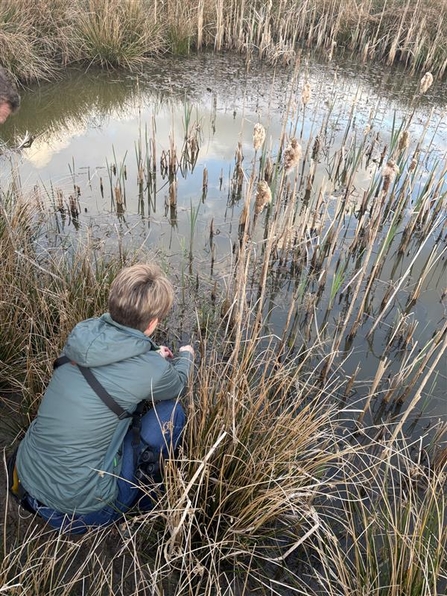
Lorna Bennett, Reserve Officer at Brockholes, crouched over a pond looking for great crested newts by Lucy Coxhead
While the Government talked, at the second reading of the Bill, about pump-priming nature restoration so that there was action on the ground ahead of impact, the Bill itself does not stipulate this.
Without this, we lose another fundamental existing principle from the current Habitats Regulations, where any mitigation must be in place prior to impact. This strict test is the only effective one we have, and this now looks set to be replaced by the levy.
Other mechanisms cannot be relied upon – we’ve been ‘burnt’ before by pots being filled but not spent and nature not seeing the reward. The apparent disappearance into Treasury coffers of this year’s water fines that would otherwise fill the Water Restoration Fund doesn’t bode well for a different approach under this Government.
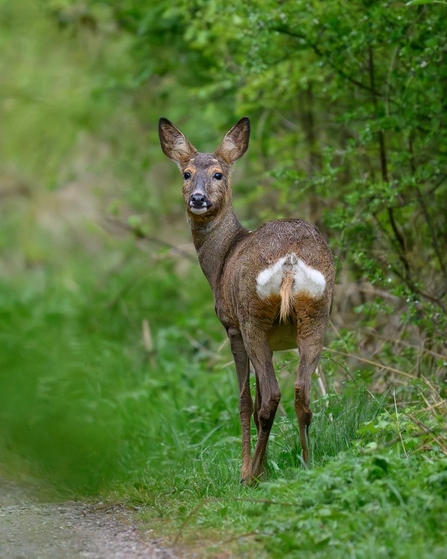
Roe deer at Brockholes Credit Steve Liptrot Photography
In Lancaster City District, we’re currently dealing with a planning application on a site that was supposed to have been restored for nature as a condition of an earlier national infrastructure development consented in 2014! A recent report found that only half of the promises to mitigate harm to nature from development had been kept.
A more effective approach to development could be achieved without tearing up current nature protections and principles. Proper upfront investment in nature restoration that delivers significant improvement for nature and provides the necessary infrastructure for sustainable growth is not only possible: it’s essential.
Across Greater Manchester, Liverpool City Region, and Lancashire, we and our partners have done or are doing the mapping through the statutory Local Nature Recovery Strategies (LNRS): we know where the network needs to be – let’s secure it now and start paying forward.
How about a compulsory purchase scheme for securing natural infrastructure, and the same urgency and political drive behind this as there is for hard infrastructure? After all, healthy nature is absolutely vital to our long-term success as a nation.
What’s at stake
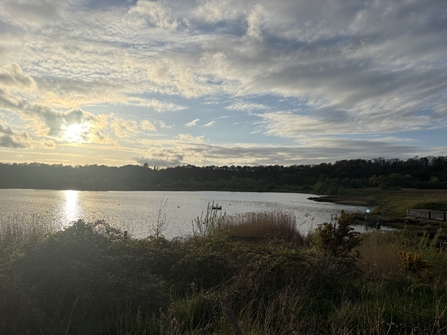
Brockholes at sunset by Lucy Coxhead
“Win-win”s are possible if we start thinking about how nature can help create healthy, sustainable places to live and work for the future; but the short-term shelving of nature’s needs, to clear the way for "build, build, build” means everyone loses in the long run. This Bill not only creates huge risks for wildlife; it also risks creating further delays and uncertainty for developers.
Just as key sectors like insurance and food production are now doing, Government needs to properly recognise that climate breakdown and ecosystem collapse are the biggest risks to our economy and security and start taking responsibility for the long-term health and prosperity of the nation.
Speak up for Nature!
The Planning & Infrastructure Bill is now at committee stage which means that a group of MPs will bring forward, discuss, and select amendments to the Bill until 22nd May at the latest, when it’ll go back for a detailed debate in the House of Commons.
At this stage, it is very important to raise your concerns about the Bill and the problems it will cause for nature. Speaking up can help us to secure a pause and rethink on Part 3 of the Bill.
Contact your MP, using our template as a guide, available here.
Remember, personal messages have the biggest impact – so feel free to amend this template and make it your own. If you like you can include a link to this blog which provides more detail about the risks. And to bring it to life, do include details of your local wildlife, green spaces and why nature is important to you.
Unsure who is your MP? Find out here.
Give nature a voice, write to your MP today.
